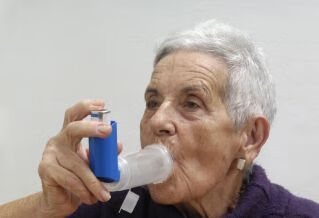
月经性哮喘可以并发哪些疾病?
哮喘在临床上属于呼吸系统的常见病,多发病,而且是以青少年为主,特别是对于有哮喘家族史的人群来说,哮喘的发病率是比较高的。月经性哮喘在临床上也是比较多见的,一般是在月经期出现的呼吸困难,胸闷,憋喘,咳嗽等症状。那么月经性哮喘可以并发哪些疾病呢?
哮喘在临床上属于慢性疾病,一般很难达到根治的目的,临床上的治疗主要以药物治疗维持治疗为主,尽可能的防止哮喘的急性发作,同时长期服用药物来控制哮喘病情的发展。在月经性哮喘有可能导致患者的肺功能损伤,引起肺源性心脏病,呼吸衰竭,可能引起肺性脑病,比较常见的是合并有肺部感染等,患者可能会出现发热,全身乏力等症状。其中长期哮喘导致的肺功能损伤,进而引起肺源性心脏病,在临床上是比较多见的,要积极的易控制哮喘为主,尽可能地减轻患者肺功能的损伤,延缓肺心病出现的时间。
总之,从临床上来看哮喘是分很多类型,不同的类型所导致的并发疾病是比较相似的,常见的是肺部感染,肺源性心脏病,呼吸衰竭等,要积极地通过完善检查来明确患者的诊断,然后选择合适的药物来控制哮喘的发展,尽可能地提高患者的生存质量,同时积极地控制疾病的发展,能有效地提高哮喘的控制率。

支气管舒张试验阳性一定就是哮喘吗?答案是否定的。有大约 10%的慢阻肺患者,也可以见到支气管舒张试验阳性,但最大可逆程度时 fev1/fvc 仍然小于 0.7。
那么支气管舒张试验阴性就一定不是哮喘吗 ?答案依然是否定的。一次支气管舒张试验阴性并不表示气道阻塞一定是不可逆的,或支气管舒张剂治疗无效,需要仔细分析原因,必要时重复检查。需要分析有没有以下因素。第一,药物吸入方法不当。第二,药物吸入剂量不足。第三,气道对该种支气管舒张药物不敏感。第四,气道黏膜水肿,气道狭窄,无可舒张性。第五,痰液等分泌物阻塞气道。
综合以上分析,支气管舒张试验阴性,一定是慢性阻塞性肺疾病吗?答案是否定的。
支气管舒张试验阳性,一定不是慢性阻塞性肺疾病吗?答案还是否定的。
在做了肺功能,支气管舒张试验阳性,医生说还是不能确定是哮喘,或者做了支气管舒张试验阴性,医生说还是不能排除哮喘,现在你应该明白为什么了吧!

穴位贴治法治疗支气管哮喘、慢性支气管炎
此法为中医治未病思想的具体应用,为“冬病夏治”法。
处方:甘遂、白芥子、细辛、元胡各 15g 共研细末备用。
贴敷穴位:取双侧肺腧、 心腧、膈腧 6 个穴位。
方法:将上药粉用生姜汁调成药饼六个,敷于穴位上,用麝香壮骨膏贴牢,敷药后有热、麻、痛感觉,局部皮肤发红,有时会起泡,持续贴敷 4 小时后取下药物。本法在夏季初伏、中伏、末伏各进行一次。可连续貼 3 年。
三伏贴,是一种膏药,在三伏天贴敷,属季节性疗法。“三伏”是初伏、中伏和末伏的统称,是一年中最热的时节。每年出现于阳历 7 月中旬到 8 月中旬。三伏贴理论根据是中医的“冬病夏治”理论。
三伏贴疗法,对支气管哮喘、肺气肿、过敏性鼻炎等冬天易发作的宿疾,在一年中最热的三伏天(这段时间是人体阳气最盛的),以辛温祛寒药物贴在背部不同穴位治疗,以减轻冬季气喘发作的程度。
1、贴敷时间宜在晴天上午,一般成人贴敷 6-8 小时,儿童 2-4 小时。根据个体差异,贴敷时间也可以做适当调整。贴敷期间,慎食辛辣、海鲜、羊肉、蘑菇等发物。
2、贴敷后局部皮肤微红或有色素沉着、轻度搔痒均为正常反应。
3、贴敷后皮肤局部出现刺痒、灼热、疼痛感觉时,应立即取下药膏,清除局部残余药物,禁止抓挠,不宜擅自涂抹药物,一般可自行痊愈。
4、尽量保持涂药处的干燥,不要对着空调的冷风吹。在贴敷期忌食生冷、油腻、辛辣的食物。不要吃高蛋白、虾蟹类海鲜。贴药当天不能游泳,4-6 个小时内不要洗冷水澡。
5、建议接受冬病夏治的患者要在饮食、生活上有所节制,不要贪凉。要远离空调,因为进入空调房后,皮肤毛孔收缩,影响药物的渗入;还应少吃冷饮,冷饮不但伤及脾胃,还可使沉积在体内的寒气凝滞,影响疗效。
6、三伏敷贴不是治疗慢性病的特效药,不能完全替代其他治疗,原来在服药的慢性病患者,不要盲目减药、停药。

一是没有找对医生
哮喘是一个发作性疾病,早期及轻症患儿平时症状不明显,当遇到过敏原或感冒后就发作,经治疗后好转。如果给孩子看病的医生不是儿科呼吸专业的医生,可能只对症治疗当下的症状,没有评估孩子未来的风险,没有制定预防的方案。所以就会反复发作。在门诊我经常遇到控制不好的孩子原来给予治疗的医生不是哮喘专业的医生,反复给予不必要的输液、抗生素和全身激素治疗。
二是没有脱离过敏原
在门诊有的孩子按照治疗方案规范治疗,但是仍有发作,孩子对螨虫过敏,通过询问发现,孩子床上一床公仔,还有毛毯,蚊帐几个月没洗,家里又有人抽烟,这些都是哮喘的诱发因素。
三是家长的顺从性差,总是担心吸入激素副作用
到目前为止,《全球哮喘防治的创议(GINA)》和发达国家的哮喘防治指南以及我国的哮喘防治指南明确指出:吸入皮质激素疗法是控制哮喘首选治疗方案,副作用最小,效果最好,有证据表明治疗剂量,如吸入布地奈德每日 400 微克,连续 2 年,不影响孩子最终身高,不影响生长发育,不影响骨质代谢,实际上只要规范治疗,很少的孩子需要大剂量吸入 2 年。有的家长谈激素色变,不按医嘱用药,所以孩子会反复发作。
四是吸入方法不正确
吸入治疗的装置是有要求的,如 8 岁以下孩子吸入气雾剂要用储雾罐,舒利迭适用于 5 岁以上,信必可适用于 6 岁以上,同时要掌握吸入方法,不然治疗效果就不好。
五是疗程不到就减量或停药
哮喘是个慢性病,治疗气道的慢性炎症要有个过程,指南推荐阶梯治疗方案:只有哮喘控制(符合以上 6 个条件)超过 3 个月以上,才能减量,降为下一阶梯治疗,不然要维持原治疗或升阶梯治疗。有的家长看到孩子一段时间无咳喘就擅自减量和停药,导致孩子反复发作。
六是难治性哮喘
经规范治疗效果不好,排除其他疾病,除外环境因素及吸入技术问题,有可能是难治性哮喘。这样的孩子要查外周血 IgE,如果增高,可以考虑皮下注射 IgE 单抗治疗。
综上所述,孩子哮喘的防治是个系统工程,作为家长要了解哮喘,知悉目前治疗哮喘的最好方案,找对医生后,制定一个短期和长期方案,评估一下未来的风险,掌握孩子哮喘急性发作后的预案,控制哮喘症状,避免急性发作,最好在青春发育前治愈哮喘,以防气道重塑,避免发展为成人哮喘。希望每个哮喘的孩子和正常儿童一样运动和生活!

当地时间10月29日礼来宣布了Ⅲb期临床试验(TRAILBLAZER-ALZ 6)的积极结果,对于早期症状性阿尔茨海默病成人患者,用改良滴定方案接受donanemab治疗的患者在24周主要终点时,伴水肿/积液的淀粉样蛋白相关影像学异常(ARIA-E)有所减少。
donanemab这个新药在今年7月获批于美国,又在之后获日本厚生劳动省、英国药品和医疗产品监管局批准,用于轻度阿尔茨海默病、轻度认知功能障碍的治疗。donanemab在国内2023年取得突破性治疗药物认定,并纳入优先审评审批程序,目前还在审评审批过程中。
 CDE官网截图
CDE官网截图
但在FDA说明书中有黑框警告,大意是应用该药时应注意淀粉样蛋白相关影像学异常(ARIA),表现为ARIA-E和ARIA伴含铁血黄素沉积(ARIA-H),通常发生在治疗早期,且无症状,很少发生严重和危及生命的事件。本次试验的积极结果和这个黑框警告相关。一起来看详情。

FDA说明书截图
给药方式有哪些改变?会不会影响效果?
TRAILBLAZER-ALZ 6是一项多中心随机双盲Ⅲb期研究,主要研究donanemab的不同给药方案对早期症状性AD患者ARIA-E和淀粉样蛋白清除率的影响,这里的早期AD指的是轻度认知障碍(MCI)和轻度痴呆疾病阶段。

给药方式和既往不同,既往标准给药方案是在前三次输注时接受2瓶(700mg)donanemab,然后再接受4瓶(1400mg);改良滴定方式是患者第一次输注1瓶(350mg),第二次输注2瓶(700mg),第三次输注3瓶(1050mg),此后每次输注4瓶(1400mg)。
研究的主要终点是第24周时患者出现ARIA-E占总参与者的比例,结果显示接受改良滴定方式的患者ARIA-E发生率为14%,而标准给药方案为24%,相对风险降低41%。载脂蛋白E(APOE)是已知的阿尔茨海默病遗传风险因素的携带者,在这些患者中,19%患者在改良滴定时患有ARIA-E,而标准给药方案中为57%,相对风险降低67%。
看到这里你或许也有疑问,虽然ARIA-E的发生风险降低了,但改良滴定方案会不会影响疗效?答案是不会。
与接受标准给药方案的患者相比,改良滴定患者淀粉样斑块和p-tau217减少。改良滴定的患者的淀粉样斑块水平较基线平均降低 67%,而标准给药组患者为69%。
参考来源
1.Modified Titration of Donanemab Demonstrated Reduction of ARIA-E in Early Symptomatic Alzheimer's Disease Patients in Phase Ⅲb study.
2.CED官网.
3.A Study of Different Donanemab (LY3002813) Dosing Regimens in Adults With Early Alzheimer's Disease (TRAILBLAZER-ALZ 6).

当地时间10月29日,阿西米尼(asciminib)获美国食品药品管理局(FDA)加速批准[1] ,用于慢性期新诊断的费城染色体阳性慢性粒细胞白血病(Ph+CML)成年患者。CML是一种骨髓和血细胞癌症,通常由费城染色体的异常染色体引起。在一线治疗中,约1/3的患者会出现下列问题:由于不良反应或者治疗无效而停止酪氨酸激酶抑制剂(TKI)治疗。
为了解决这一问题,需要开发新的药物,asciminib就是解决这一困境的新药。早在2022年8月,加拿大药物和卫生技术局(CADTH)建议[2] :“若满足条件,可通过公共药物计划报销asciminib用于治疗费城染色体阳性慢性粒细胞白血病。”
asciminib为何得到FDA的青睐?
本次获批基于一项III期多中心随机研究,研究目的是比较每日80mg的asciminib与TKI治疗的疗效。TKI治疗是接受伊马替尼、尼洛替尼、达沙替尼或博舒替尼任意一种治疗。
共有405名患者被随机分配(1:1)进两组治疗。主要疗效结局指标是48周时的主要分子反应(MMR)率。这个指标是慢性髓性白血病的关键指标,这个比例越高,说明该治疗在基因水平上对疾病的控制效果越好,能够更有效地抑制疾病相关基因的表达,进而有望更好地控制疾病的进展、改善患者的症状和预后。
研究结果显示,48周时MMR率方面,asciminib组中为68%(95% CI: 61, 74),TKI组为49%(95% CI: 42, 56),二者相差19%。细看具体的TKI,入组伊马替尼和其他TKI药物入组比例为1:1;asciminib组的MMR率为69%(95% CI: 59, 78),而伊马替尼组为40%(95% CI: 31, 50),相差近30%(95% CI: 17, 42)。
这个新药安全吗?每周需要打几次药?
根据FDA数据显示,在新诊断和既往接受过治疗的患者,应用新药最常见的不良反应(≥20%)是肌肉骨骼疼痛、皮疹、疲劳、上呼吸道感染、头痛、腹痛和腹泻。若只看新诊断的患者,最常见的实验室异常(≥40%)是淋巴细胞计数降低、白细胞计数降低、血小板计数降低、中性粒细胞计数降低等。
根据FDA已批准的asciminib说明书,用药期间还需要注意一下事项:
1.骨髓抑制 :用药期间可能因出现骨髓抑制,发生血小板减少症、中性粒细胞减少症和贫血。用药应在治疗的前3个月,需要每两周进行一次全血细胞计数,此后每月进行一次检测,从而判断患者有无骨髓抑制症状。根据严重程度,咨询医生是否需要停药。
2.胰腺毒性 :患者可能出现血清脂肪酶和淀粉酶无症状升高,每月需评估血清脂肪酶和淀粉酶水平,如果您有胰腺炎,则注意主动告知医生,需要进行频率更高的检测。
3.高血压风险 :可能出现3级或4级高血压风险,应注意检测血压。
4.超敏反应 :可能出现3级或4级超敏反应,包括皮疹、水肿和支气管痉挛。如果出现这些症状,需及时反馈医生,医生会根据超敏反应的体征和症状,开始适当的治疗。
5.心血管毒性 :如果您有心血管病史,需要告知医生;对于3级或更高级别的心血管毒性,医生会考虑暂停用药、减少剂量或永久停药。
6.胚胎/胎儿毒性 :若您在怀孕期间用药或在服用药物期间怀孕,可能对孩子有潜在风险。这个新药是口服药,需要根据不同的给药剂量(80mg或40mg)每天/或每两天用药。
近些年来,还有哪些白血病药物获批FDA?
根据FDA肿瘤学/血液系统恶性肿瘤批准通知,白血病相关新药整理如下表。
另外可以看出21年时asciminib已获批白血病治疗,但限定既往接受过两种或更多TKIs治疗,本次获批属于扩大适应证。

参考来源:
1.FDA grants accelerated approval to asciminib for newly diagnosed chronic myeloid leukemia. 2.Asciminib(Scemblix):CADTHReimbursementRecommendation:Indication:ForthetreatmentofadultpatientswithPhiladelphiachromosome-positivechronicmyeloidleukemia(Ph+CML)inchronicphase(CP)previouslytreatedwith2ormoretyrosinekinaseinhibitors.Ottawa(ON):CanadianAgencyforDrugsandTechnologiesinHealth;2022Aug.PMID:38713779. 3.AStudyofOralAsciminibVersusOtherTKIsinAdultPatientsWithNewlyDiagnosedPh+CML-CP. 4.Product information:SCEMBLIX-asciminibtablet,filmcoated.UpdatedAugust7,2024. 5.Oncology(Cancer)/HematologicMalignanciesApprovalNotifications.

以下内容来源于新英格兰医学杂志。
Presentation of Case

Differential Diagnosis
Movement Disorders
Seizures
Functional Movement Disorder
Dyskinesia
Limb-Shaking TIAs
Clinical Impression and Initial Management

Clinical Diagnosis
Dr. Albert Y. Hung’s Diagnosis
Pathological Discussion

Pathological Diagnosis
Additional Management
Final Diagnosis

以下内容来源于新英格兰医学杂志。
Presentation of Case
Dr. Christine M. Parsons (Medicine): A 75-year-old woman was evaluated at this hospital because of arthritis, abdominal pain, edema, malaise, and fever.
Three weeks before the current admission, the patient noticed waxing and waning “throbbing” pain in the right upper abdomen, which she rated at 9 (on a scale of 0 to 10, with 10 indicating the most severe pain) at its maximal intensity. The pain was associated with nausea and fever with a temperature of up to 39.0°C. Pain worsened after food consumption and was relieved with acetaminophen. During the 3 weeks before the current admission, edema developed in both legs; it had started at the ankles and gradually progressed upward to the hips. When the edema began to affect her ambulation, she presented to the emergency department of this hospital.
A review of systems that was obtained from the patient and her family was notable for intermittent fever, abdominal bloating, anorexia, and fatigue that had progressed during the previous 3 weeks. The patient reported new orthopnea and nonproductive cough. Approximately 4 weeks earlier, she had had diarrhea for several days. During the 6 weeks before the current admission, the patient had lost 9 kg unintentionally; she also had had pain in the wrists and hands, 3 days of burning and dryness of the eyes, and diffuse myalgias. She had not had night sweats, dry mouth, jaw claudication, vision changes, urinary symptoms, or oral, nasal, or genital ulcers.
The patient’s medical history was notable for multiple myeloma (for which treatment with thalidomide and melphalan had been initiated 2 years earlier and was stopped approximately 1 year before the current admission); hypothyroidism; chikungunya virus infection (diagnosed 7 years earlier); seropositive erosive rheumatoid arthritis affecting the hands, wrists, elbows, and shoulders (diagnosed 3 years earlier); vitiligo; and osteoarthritis of the right hip, for which she had undergone arthroplasty. Evidence of gastritis was reportedly seen on endoscopy that had been performed 6 months earlier. Medications included daily treatment with levothyroxine and acetaminophen and pipazethate hydrochloride as needed for cough. The patient consumed chamomile and horsetail herbal teas. She had no known allergies to medications, but she had been advised not to take nonsteroidal antiinflammatory drugs after her diagnosis of multiple myeloma.
Approximately 5 months before the current admission, the patient had emigrated from Central America. She lived with her daughter and grandchildren in an urban area of New England. She had previously worked in health care. She had no history of alcohol, tobacco, or other substance use. There was no family history of cancer or autoimmune, renal, gastrointestinal, pulmonary, or cardiac disease.
On examination, the temporal temperature was 37.1°C, the heart rate 106 beats per minute, the blood pressure 152/67 mm Hg, and the oxygen saturation 100% while the patient was breathing ambient air. She had a frail appearance and bitemporal cachexia. The weight was 41 kg and the body-mass index (the weight in kilograms divided by the square of the height in meters) 15.2. Her dentition was poor; most of the teeth were missing, caries were present in the remaining teeth, and the mucous membranes were dry. She had abdominal tenderness on the right side and mild abdominal distention, without organomegaly or guarding. Bilateral axillary lymphadenopathy was palpable. Infrequent inspiratory wheezing was noted.
The patient had swan-neck deformity, boutonnière deformity, ulnar deviation, and distal hyperextensibility of the thumbs (Fig. 1). Subcutaneous nodules were observed on the proximal interphalangeal joints of the second and third fingers of the right hand and on the proximal interphalangeal joint of the fourth finger of the left hand. Synovial thickening of the metacarpophalangeal joints of the second fingers was noted. There was mild swelling and tenderness of the wrists. She had pain with flexion of the shoulders and right hip, and there was subtle swelling of the shoulders and right knee. Pitting edema (3+) and vitiligo were noted on the legs. No sclerodactyly, digital pitting, telangiectasias, appreciable calcinosis, nodules, nail changes (including pitting), or tophi were present. The remainder of the examination was normal.

The blood levels of glucose, alanine aminotransferase, aspartate aminotransferase, bilirubin, globulin, lactate, lipase, magnesium, and phosphorus were normal, as were the prothrombin time and international normalized ratio; other laboratory test results are shown in Table 1. Urinalysis showed 3+ protein and 3+ blood, and microscopic examination of the sediment revealed 5 to 10 red cells per high-power field and granular casts. Urine and blood were obtained for culture. An electrocardiogram met (at a borderline level) the voltage criteria for left ventricular hypertrophy.

Dr. Rene Balza Romero: Computed tomography (CT) of the chest, abdomen, and pelvis, performed after the intravenous administration of contrast material, revealed scattered subcentimeter pulmonary nodules (including clusters in the right middle lobe and patchy and ground-glass opacities in the left upper lobe), trace pleural effusion in the left lung, coronary and valvular calcifications, and trace pericardial effusion, ascites, and anasarca. The scans also showed slight enlargement of the axillary lymph nodes (up to 11 mm in the short axis) bilaterally and a chronic-appearing compression fracture involving the T12 vertebral body.
Dr. Parsons: Morphine and lactated Ringer’s solution were administered intravenously. On the second day in the emergency department (also referred to as hospital day 2), the blood levels of haptoglobin, folate, and vitamin B12 were normal; other laboratory test results are shown in Table 1. A rapid antigen test for malaria was positive. Wright–Giemsa staining of thick and thin peripheral-blood smears was negative for parasites; the smears also showed Döhle bodies and basophilic stippling. Antigliadin antibodies and anti–tissue transglutaminase antibodies were not detected. Tests for hepatitis A IgG and hepatitis C antibodies were positive. Tests for hepatitis B core and surface antibodies were negative. A test for human immunodeficiency virus type 1 (HIV-1) and type 2 (HIV-2) was negative.
Findings on abdominal ultrasound imaging performed on the second day (Fig. 2A and 2B) were notable for a small volume of ascites and kidneys with echogenic parenchyma. Ultrasonography of the legs showed no deep venous thrombosis. An echocardiogram showed normal ventricular size and function, aortic sclerosis with mild aortic insufficiency, moderate tricuspid regurgitation, a right ventricular systolic pressure of 39 mm Hg, and a small circumferential pericardial effusion. Intravenous hydromorphone was administered, and the patient was admitted to the hospital.

On the third day (also referred to as hospital day 3), nucleic acid testing for cytomegalovirus, Epstein–Barr virus, and hepatitis C virus was negative, and a stool antigen test for Helicobacter pylori was negative. An interferon-γ release assay for Mycobacterium tuberculosis was also negative. Oral acetaminophen and ivermectin and intravenous hydromorphone and furosemide were administered.
Dr. Balza Romero: Radiographs of the hands (Fig. 2C through 2F) showed joint-space narrowing of both radiocarpal joints and proximal interphalangeal erosions involving both hands. Radiographs of the shoulders showed arthritis of the glenohumeral joint and alignment suggestive of a tear of the right rotator cuff. A radiograph of the pelvis showed diffuse joint-space narrowing of the left hip, without osteophytosis, and an intact right hip prosthesis.
Dr. Parsons: Diagnostic tests were performed, and management decisions were made.
Differential Diagnosis
Cancer
Infectious Disease
Autoimmune Disease
Hypocomplementemia
Dr. Beth L. Jonas’s Diagnosis
Pathological Discussion
Pathological Diagnosis
Discussion of Management
Follow-up
Final Diagnosis
Overlap syndrome of rheumatoid arthritis and systemic lupus erythematosus complicated by proliferative lupus nephritis, superimposed on amyloid A amyloidosis.
展开更多
























